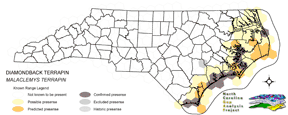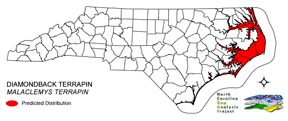
| Taxa: |
| Order: |
| Family: |
| Reptilia |
| Testudines |
| Emydidae |
| NatureServe Global Rank: |
| NatureServe State (NC) Rank: |
| G4 |
| S3 |
| Federal Status: |
| NC State Status: |
| --- |
| SC |


| Land Unit |
| US Fish & Wildlife Service |
| US Forest Service |
| US National Park Service |
| US Department of Defense |
| NC State Parks |
| NC University System |
| NC Wildlife Res. Com. |
| NC Forest Service |
| NC Div. of Coastal Mgmt. |
| Local Governments |
| Non-Governmental Org. |
| Other Public Lands |
| Private Lands |
| GAP Status 1-2 |
| All Protected Lands |
| Statewide |
| Hectares |
| 2,223.36 |
| 44.91 |
| 1,264.86 |
| 2,044.17 |
| 748.80 |
| 2.52 |
| 708.75 |
| 0.00 |
| 812.16 |
| 1.62 |
| 383.94 |
| 4.23 |
| 19,446.57 |
| 6,147.54 |
| 8,191.44 |
| 27,685.89 |
| Acres |
| 5,494.04 |
| 110.98 |
| 3,125.54 |
| 5,051.25 |
| 1,850.32 |
| 6.23 |
| 1,751.36 |
| 0.00 |
| 2,006.89 |
| 4.00 |
| 948.74 |
| 10.45 |
| 48,053.51 |
| 15,190.90 |
| 20,241.49 |
| 68,413.31 |
| % of Dist. on |
| Prot. Lands |
| 27.1 % |
| 0.5 % |
| 14.9 % |
| 25.0 % |
| 9.1 % |
| < 0.1 % |
| 8.7 % |
| 0.0 % |
| 9.9 % |
| 4.7 % |
| 4.7 % |
| < 0.1 % |
| 0.0 % |
| 75.0 % |
| ----- |
| ----- |
| % of Dist. on |
| All Lands |
| 8.0 % |
| 0.2 % |
| 4.6 % |
| 7.4 % |
| 2.7 % |
| < 0.1 % |
| 2.6 % |
| 0.0 % |
| 2.9 % |
| < 0.1 % |
| 1.4 % |
| < 0.1 % |
| 70.2 % |
| 22.2 % |
| ----- |
| ----- |
|
NATURE SERVE GLOBAL HABITAT COMMENTS: Coastal marshes, tidal flats, coves, estuaries, and lagoons behind barrier beaches; brackish and salt water (but basically retricted to estuarine situations; intolerant of long-term exposure to freshwater or 100% salt water). Burrows into mud when inactive (Ernst and Barbour 1972); in Virginia, has been observed hibernating in moist sand 8 m from the high tide mark. May venture into grassy lowlands at high tide (Ashton and Ashton 1985). Hatchlings move to the closest terrestrial vegetation after emergence from nest. Small individuals may use cover of tidal wrack and dense mats of vegetation (Lovich et al. 1991). Eggs are laid in a nest dug in sandy marsh edge, offshore island, or dune (vegetated or unvegetated), above high tide mark. Nests of different females may be dispersed or aggregated. NATURE SERVE STATE HABITAT COMMENTS: Brackish water. |
| Code | Name | Description | NC Natural Heritage Program Equivalent |
| 378 | Ocean Beaches | Open beach sand. | Upper Beach |
| 3 | Tidal Marsh | Fresh and brackish tidal marshes, including cord grass, wild rice, sawgrass and needlerush alliances. | Brackish Marsh, Interdune pond, Maritime wet grassland |
| 124 | Maritime Scrubs and Tidal Shrublands | Coastal shrubs including wax-myrtle, swamp rose, alder, yaupon, and greenbriar. | Maritime Shrubs, Salt Shrub |
| 375 | Hypersaline coastal salt flats | Tidal flats within salt marshes, including saltmeadow cordgrass or sea-purslane dominated alliances. | Salt Marsh |
| 372 | Interdune Herbaceous Wetlands | Dune swales with permanently flooded to intermittently exposed hydrology. Species composition depends on salinity and can include cut grass, spike-rush, mosquito fern, and hornwort. | Interdune Pond, Maritime Wet Grasslands |
| 371 | Maritime Grasslands | Dune grass community consisting of sea oats and beach grasses. | Dune grass, Maritime dry grassland |
| 8 | Open water | Open water without aquatic vegetation. | No equivalent |
|
Montevecchi, W. A., and J. Burger. 1975. Aspects of the reproductive biology of the northern diamondback terrapin Malaclemys terrapin terrapin. Am. Midl. Nat. 94:166-178.
Burger, J. 1976. Behavior of hatchling diamondback terrapins (MALACLEMYS TERRAPIN) in the field. Copeia 1976:742-748. Seigel, R. A. 1980. Nesting habits of diamondback terrapins (MALACLEMYS TERRAPIN) on the Atlantic coast of Florida. Trans. Kansas Acad. Sci. 83:239-246. Dobie, J. L. 1981. The taxonomic relationship between MALACLEMYS Gray, 1844 and GRAPTEMYS Agassiz, 1857 (Testudines:Emydidae). Tulane Stud. Zool. Bot. 23:85-102. Ernst, C. H., and R. B. Bury. 1982. Malaclemys, M. terrapin. Cat. Am. Amph. Rep. 299.1-299.4. Seigel, R. A. 1993. Apparent long-term decline in diamondback terrapin populations at the Kennedy Space Center, Florida. Herpetol. Rev. 24:102-103. Lamb, T., and M. F. Osentoski. 1997. On the paraphyly of MALACLEMYS:a molecular genetic assessment. Journal of Herptology 31:258-265. Conant, R. and J. T. Collins. 1991. A field guide to reptiles and amphibians:eastern and central North America. Third edition. Houghton Mifflin Co., Boston, Massachusetts. 450 pp. Morreale, S. J. 1992. The status and population ecology of the diamondback terrapin, MALACLEMYS TERRAPIN, in New York. Okeanos Ocean Research Foundation, Inc., Hampton Bays, New York. 76 pp. Goodwin, C. C. 1994. Aspects of the nesting ecology of the diamondback terrapin (MALACLEMYS TERRAPIN) in Rhode Island. M.S. thesis, University of Rhode Island. vii + 84 pp. Hurd, L. E., G. W. Smedes, and T. A. Dean. 1979. An ecological study of a natural population of diamondback terrapins (MALACLEMYS TERRAPIN TERRAPIN) in a Delaware salt marsh. Estuaries 2:28-33. Burger, J., and W. A. Montevecchi. 1975. Nest site selection in the terrapin MALACLEMYS TERRAPIN. Copeia 1975:113-119. Burger, J. 1977. Determinants of hatching success in the diamondback terrapin Malaclemys terrapin. Am. Midl. Nat. 97:444-446. Tucker, A. D., N. N. FitzSimmons, and J. W. Gibbons. 1995. Resource partitioning by the estuarine turlte MALACLEMYS TERRAPIN:trophic, spatial, and temporal foraging constraints. Herpetologica 51:167-181. Seigel, R. A., and J. W. Gibbons (compilers). 1995. Workshop on the ecology, status, and management of the diamondback terrapin (MALACLEMYS TERRAPIN), Savannah River Ecology Laboratory, 2 August 1994:Final results and recommendations. Chelonian Conservati Auger, P. J., and P. Giovannone. 1979. On the fringe of existence. Diamondback terrapins at Sandy Neck. The Cape Naturalist 8:44-58. Seigel, R. A. 1983. Occurrence and effects of barnacle infestations on diamondback terrapins (MALACLEMYS TERRAPIN). American Midland Naturalist 109:34-39. Lovich, J. E., and J. W. Gibbons. 1990. Age at maturity influences adult sex ration in the turtle MALACLEMYS TERRAPIN. Oikos 59:126-134. Ernst, C. H., and R. W. Barbour. 1972. Turtles of the United States. Univ. Press of Kentucky, Lexington. x + 347 pp. Seigel, R. A. 1984. Paramenters of two populations of diamondback terrapins (MALACLEMYS TERRAPIN) on the Atlantic coast of Florida. Pages 77-87 in R. A. Seigel et al., editors. Vertebrate ecology and systematics--a tribute to Henry S. Fitch. Mus. Nat. His Behler, J. L., and F. W. King. 1979. The Audubon Society field guide to North American reptiles and amphibians. Alfred A. Knopf, New York. 719 pp. Martof, B. S., W. M. Palmer, J. R. Bailey, and J. R. Harrison, III. 1980. Amphibians and reptiles of the Carolinas and Virginia. University of North Carolina Press, Chapel Hill, North Carolina. 264 pp. Ashton, R. E., Jr., and P. S. Ashton. 1985. Handbook of reptiles and amphibians of Florida. Part two. Lizards, turtles & crocodilians. Windward Pub., Inc., Miami. 191 pp. Lovich, J. E., et al. 1991. Behavior of hatchling diamondback terrapins (MALACLEMYS TERRAPIN) released in a South Carolina salt marsh. Herpetol. Rev. 22:81-83. |
For more information please contact them at:
NC-GAP Analysis Project
Dept. of Zoology, NCSU
Campus Box 7617
Raleigh, NC 27695-7617
(919) 513-2853
www.basic.ncsu.edu/ncgap